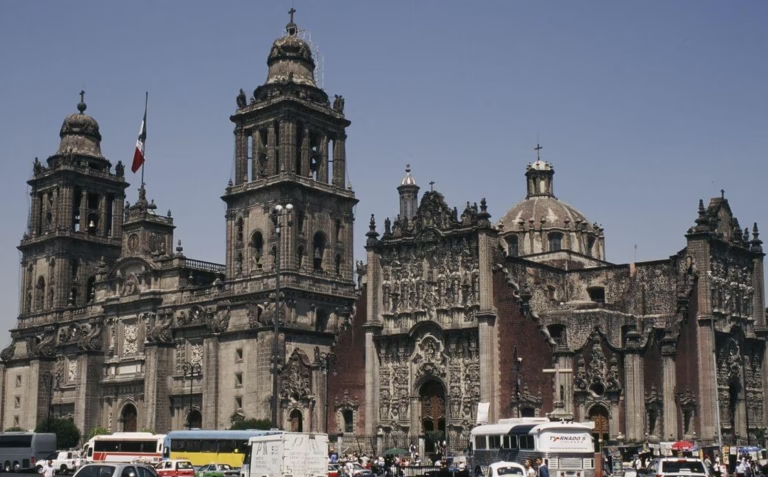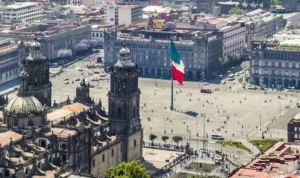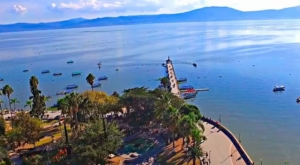Metropolitan Cathedral in Mexico City

The history of the Metropolitan Cathedral’s creation spans three centuries, from 1573 to 1813. So it makes sense that the architecture is an amalgamation of the three distinct styles which dominated during the lengthy process of its construction; Baroque, Neo-Classic, and Neo-Renaissance. Prompted in 1544 by a need to replace the original church that formerly occupied the site following the conquest of Aztec hub Tenochtitlan, not even three centuries of development could make sure the foundations were sufficiently resilient. The cathedral – much like the rest of Mexico City – gradually sinks year after year into the shifting lake upon which it was built.
Urban legend even asserts that an underground pathway connects the neighbouring Templo Mayor with the cathedral. Hearsay at its finest. The link between the two structures is irrefutable though; most of the Templo Mayor’s stone is built into the cathedral. It’s even claimed that Spanish Conquistador Hernán Cortes was responsible for laying the first stone.
Despite being a great source of Mexican pride, the cathedral which now houses the seat of the Roman Catholic Archdiocese of Mexico was actually designed by Spaniard Claudio de Arciniega and inspired by Valladolid’s Gothic architecture. All the cathedral portals’ high reliefs are equally foreign in inspiration, influenced by Flemish Peter Paul Rubens. However, the impressive bell towers are of Xalapan design and house twenty-five bells. The largest of these, Santa Maria de Guadalupe, weighs in at 13,000 kilos, but she’s not the only bell adorned with a name. Another is known as Doña Maria – yes, like the famous mole paste brand.
Yet the external architecture is not the biggest draw of this popular cathedral, as the internal offerings are just as magnificent. Many works of art, religious relics, and crypts adorn every orifice, including in the sixteen chapels. Gold coats every surface and towering ceilings add to the grandeur of the Altars of Forgiveness and of the Kings. The fire damaged the Altar of Forgiveness in 1967 along with the Americas’ biggest 18th-century organs. This fire led to the discovery of previously hidden treasures, including over fifty paintings, historical documents concerning Hernán Cortes, and the burial place of the first governor of Veracruz, Miguel Barrigan.
Mexico is a big country, and we only visited two places in May and June 2019. however, my ex-wife and I agree we have found the country we wish to emigrate to.
The first town we stayed in was San Miguel de Allende, a very nice place with lots of helpful people. However, after one day there I wrote this town off because it has far too much pollution from busses that pass every few minutes. Along, with old delivery trucks charging around, supplying the shops and restaurants with their orders. Taxis, it seemed like there were hundreds all following each other, with most plying for hire.
From there we drove down to Ajijic on the shore of Lake Chapala, this is a very nice area, loverly people and prices are lower than in San Miguel. We drove all along the north shore of Lake Chapala from Jocotepec to Chapala and fell in love with this area, and in particular, Chapala.
This is the place for us. We feel we do not need to look any further. Prices in the indoor market in Chapala are unbelievably low. The two mangoes I purchased were so cheap I had to ask if the lady had made a mistake. I paid 9 Mexican pesos for the two, which is equivalent to 42 pence, or 51 US cents, and they were so sweet and juicy.
While we were there, it was the rainy season, I thought, I had not planned this trip very well, however, a lovely Canadian lady said to me, do not worry because it only rains at night. I looked at her and thought, ya; I do not believe that. I was pleasantly surprised when I found out she was 100% correct. We thought we had found Camelot.
All the small towns along Lake Chapala have a Malecón, which is a word used in Spanish-speaking countries, and especially in nations of Latin America, for a stone-built embankment, we would say esplanade or promenade along a waterfront. They are great places to take a walk, stop and have a coffee or a cool drink or maybe a meal.

Important Government Offices

Lake Chapala
Lake Chapala showing part of the Malecón.

Showing part of the Malecón at the town of Chapala
This was the town we had planned to make our home.
Sadly, that will not happen because Lucille and I got divorced. That’s another story for another day.
So I made plans to go back to Mexico on my own.
Queretaro, the town I picked to begin my new life
Because I did not want to go back to the area that Lucille and I had fallen in love with. I searched, I read, and I asked lot’s of questions from people who live in Mexico. After moving towns off the list I had drawn up, I finally settled on Queretaro.
So let me tell you why I am not living in Queretaro, Mexico.
I left England on 30th November 2020 arriving on the 1st December in Mexico City. Presented my passport believing I would receive a visa for 180 days. Because I felt I needed the six months to really know if Mexico was for me. The immigration official asked me. “What date is your return ticket” I told him the 28th of April, and then added, the ticket is an open ticket so I can change the date. Thinking this would make him give me 180 days.
He stamped my passport and let me enter. When I got through, I checked my passport and what a surprise I got; he had given me 30 days. You can imagine how I felt. Devastated was the first word that came to mind. Because you cannot negotiate with them and it is totally their decision. You have to accept what you have been given.
On the bus ride up to Queretaro, I looked at my options. The easiest would be to cross the Texas border, turn around and hope I got 180 day visa. I decided to sleep on it and would only make a decision later in the month.
I found my Air B&B and settled in, and then went for a walk. Meeting many friendly people and eating some great tasting food. Queretaro is very flat, which makes it easy to walk around, and I walked all around this town. By the third day, I knew that this was the town for me. The people were great and the food very interesting and some I had never had before. However, I never tried anything that I would not eat again, every dish was outstanding.
Over the next two weeks, I met several people that I would be happy to call friends. Everybody, whether they were Mexicans, Americans, or Europeans. I found that they were without a doubt very happy to be living in Queretaro, and they told me about places I should check out.
Around the 20th of December, I met an American while eating lunch at a little restaurant. I told him about my 30 day visa and what I planned to do. He said, you might want to re-think that, he then told me about an American he knew who also only got 30 days. He did the border run and got another 30 days. He tried one more time, and once more he got 30 days.
That was it. I decided I would not do that because the frustration would be unbearable, never mind the cost.
This meant for now, I could not stay in Mexico. However, you never know what happens down the road. I still feel this country would be a great place to live.
Removing the list that I had drawn up over the years, I looked at the next country on that list. That was Ecuador, so on December 31st I flew to Ecuador to start the visa process there.

